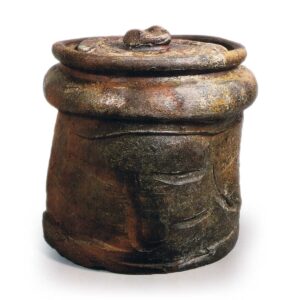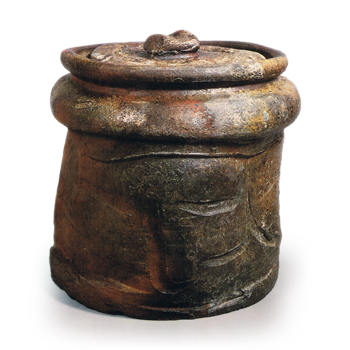
What is Bizen?
Bizen, along with Tanba, Iga, Shigaraki, and Suzu kilns, is a representative of the Sue kilns that have existed since the Middle Ages. Based on oxidizing flame firing, until the late Muromachi period (1333-1573), Bizen mainly fired jars, pots, and mortar, with the exception of special examples, and the molding was done on a wheel-thrown potter’s wheel. However, in the late Muromachi period, the style changed dramatically as it came into contact with urban culture and was used in the world of wabicha (tea ceremony). Of course, the Wabicha world recognized the rustic and subdued texture of the firing process, so the basic firing technique remained the same, but pure tea ceremony utensils were fired. Tea jars, flower vases, water jars, tea containers, tea bowls, and tea utensils, as well as plates, bowls, and tokkuri (Japanese tea utensils) began to be fired. Although the late Muromachi period and later saw the production of folk utensils, it is the tea ceremony utensils that are most representative of the Momoyama period. Although tea ceremony utensils include many items that were originally produced as folk utensils, the Momoyama period’s tea ceremony utensils were refined and diverse in form, unlike those of the medieval period.
Bizen and its relationship to tea
Among Bizen, Tamba, Iga, and Shigaraki, Shigaraki and Bizen made their earliest appearance in the tea ceremony. It is also said in a letter to Harima Furuichi that “or, as it is said to have been heated up at that time, a novice would hold a Bizen-Shigarakimono,” which suggests that Bizen and Shigarakimono were used from the Bungeki era to the Bungeki era, the period when Shukoh was active. Although it is not clear what kind of works Shukoh used, it is mentioned in the “Yamashina Gonkyo Ki” on April 8, 1406 (Oei 13) as “Bizen tea jar,” suggesting that tea jars had already been fired and that jars, mortars, or ramie buckets, which were created as miscellaneous tools, came to be used. It is assumed that jars, suribachi, or ramie barrels were used as other miscellaneous utensils.
Although they may not be considered wabicha tea utensils, tea jars were the earliest vessels related to the tea ceremony, and there is a Bizen ware jar inscribed with the date of 1363 (Jouji 2) and described in the above-mentioned “Yamashina Kotokyo no Ki,” as well as in the “Katsuragawa Jizo Ki,” dated 1558 (Koji 4), which states, “Koukado (the old name for Bizen) Shigaraki Seto The description in the “Kizaki” of “Katsuragawa Jizo Ki” (1558), “Iga, Yamato, Matsumoto, Awazu no Kizen, Kizaki etc. are put in the jar,” tells us about the disappearance during that period. In addition, the “Tsuda Sotatsu Chayu Nikki (Diary of Sotatsu Tea Ceremony)” mentions “I, mizusashi, mizukohoshi hisenmono” at the Sorikai on December 12, 1818, and “Bizen mizusashi, seomi” (fig. 36) owned by Shao’o is also known to exist, and the “Sokki Yamagami,” written in Tensho 16, mentions “Shao’o bizen tsutsu” and “Shao’o bizen mono no mene oke” (Bizen objects owned by Shaobian). It is certain that they were used as wabi-utensils after the Tembun era. Moreover, tea utensils made after the Tembun period, such as the “Bizen water jar, Seomi,” seem to have been made purely as tea utensils, judging from the shape of their mouths and the shapes of their vessels. Therefore, it is thought that tea utensils were already being made during the Tembun period, when wabicha was gaining popularity among tea masters in Sakai and other townspeople. However, it is also natural that they would have taken up miscellaneous utensils.
Bizen and Tea Ceremony Pottery (Part 3)
During the Eiroku period (1688-1704), Bizen-made water jars and tatemizu often appeared in tea ceremony records, and in particular, tatemizu with a “stick tip” or “jar lid” were widely used, and Bizen-made tea utensils were overwhelmingly popular for wabicha (tea ceremony). In the Tensho period, flower vases were also added to the collection, and most of the tea ceramics in the collection are now available, but it is thought that the Momoyama style of artifice was not fired until the Tensho period.
Tea ceramics from the Tensho period through the Bunroku, Keicho, and early Edo periods, as well as Mino, Iga, and Shigaraki kilns, seem to have been influenced by the taste of the times, with Sen no Rikyu, Furuta Oribe, and Kobori Enshu as predecessors. An overview of suzuji (water jars) and hanayu (flower vases) from the late Muromachi to Momoyama periods reveals a clear change in style. The first style seems to have been dominated around the Tensho period, when Rikyu was active, followed by the Keicho period, the heyday of Oribe Furuta, when many highly distorted pieces were fired. The first style seems to have been produced during the Tensho period when Rikyu was active, followed by the Keicho period when Furuta Oribe was at his peak. Moreover, it is thought that Bizen ware may have received more active orders for Wabi tea ceramics than Mino ware during the period from the Temmon to Tensho periods. For example, the style transition of the arrow-necked tea ceremony vase and water jar, which symbolize Momoyama tea ceremony ceramics, can be traced almost entirely in Bizen, and it is thought that such a style was probably first produced in Bizen, which became the fashion of the time and influenced Mino, Iga, Shigaraki, and even Karatsu.
However, tea ceramics are, after all, special-order items, and it is extremely difficult to observe their true nature even by examining kiln sites. However, it is clear that from Tensho to Keicho, Bizen had excellent potters who could rival those of Mino, and that they were very active, and that the bold and meticulous workmanship shown there reached a state that could not be easily achieved.
What is Bizen?
In the Kamakura period (1185-1333), Bizen ware was produced near the summit of Kumayama (Mt. Kumayama), and in the Muromachi period (1333-1568), it was produced in an open kiln on the edge of a mountain near Ibe. In the late Muromachi period, however, they began to build large kilns for mass production. In other words, they built the West Large Kiln (west of Ibe, at the eastern foot of Mt. Iou), the North Large Kiln (north of Ibe, at the southern foot of Mt. Furo), and the South Large Kiln (south of Ibe, at the northern foot of Mt. Hasehara), and it is thought that potters formed three large groups and organized themselves into groups for management. In Bizen, there were six surnames of kiln masters, including Kimura, Mori, Tongu, Terami, Oyoshi, and Kinshige, and the organization of the joint kiln continued until the Meiji Restoration. The joint kilns continued to be organized until the Meiji Restoration, and each potter began to engrave a kiln seal to distinguish his work. In addition, although some of the kiln seals may be the symbols of individual potters, most of them may have been used in place of family names, or the same kiln seal may have been used from generation to generation, and even those with the same kiln seal seem to differ considerably in their production dates. According to Mr. Matasaburo Katsura, when the remains of the large southern kiln were excavated in 1951, the Momoyama period kiln that appeared to the right of the large Edo period kiln was over 31.6 meters long and 2.3 meters wide, with a slope of 0.66 meters to 0.858 meters per meter. The pottery shards excavated from the kiln indicate that the kiln was smoking from the end of the Muromachi period to the beginning of the Edo period. As can be seen from this, among the kilns of the Momoyama period, Bizen ware has the largest number of kiln marks, and there were other kilns similar to the Nandai Kiln in the west and in the north, so it can be said that the grandeur of the kiln management was not seen in other kilns.
What is Bizen?
From the Kamakura period to the mid-Muromachi period, mountain clay was used, while in the large kiln period, mainly rice field clay was used, resulting in quite different clay tastes. Among Momoyama-era tea ceramics made of rice field clay, it is thought that different types of clay were used for different types of works, ranging from slightly coarse to extremely fine clay. The technique commonly referred to as nuri-tsuchi (lacquering clay) began in the late Muromachi period (1333-1573), and it involved the use of iron-rich common clay, which was then plastered with mud or brushed over with a brush, and later developed into Ibe-te, a technique unique to Bizen ware.
Molding was traditionally done on a cord-shaped potter’s wheel, but later changed to wheel throwing. However, the wheel was neither a hand wheel like in Mino nor a kick wheel like in Karatsu, but a separate assistant turned the wheel and the artist only shaped the clay on the wheel. In addition, as in the Mino and Karatsu styles, the potter did not make several pieces from a single lump of clay placed on the potter’s wheel, but rather placed one piece of clay for each vessel, regardless of its size, in principle using the so-called “itobiki” method. Therefore, with the exception of special pieces such as tea caddies, there are no Itokiri-Takadai pieces, all of which are Peta-Takadai, and the smaller ones have a flattened base with a spatula. For large pieces such as water jars and flower vases, the technique used is to spread fine, dried clay on the potter’s wheel for easy removal, place the bottom clay of the vessel on top of it, and then place more clay to form the vessel. After forming, the clay is cut off at the bottom with a spatula and transferred onto a drying board, the so-called ita-gaki technique.
What is Bizen?
Bizen pottery can be fired in two different ways: by directly covering the clay skin with flame or ash, or by placing the pieces inside a large jar with a lid on top, as if the jar were a saggars. The latter is called “Hidasuki” because the clay surface is whiter than that of Ko-hen ware and the straw acts on the clay surface to give it a reddish hidasuki appearance. However, most of them did not use saggars, but after the Momoyama period, some of them were put in saggars, and fragments of saggars inscribed in the first year of Keicho period have been excavated from kiln sites.
In addition to Kobizen and Hidasuki, there is another type of pottery called Ibute. Ibe-date is said to have been produced after the Keicho period, but early Ibe-date has already been produced since the late Muromachi period (1336-1573). Ibe-date is characterized by a smooth clay body with a natural glaze of a decayed leaf color, commonly called sesame glaze, on top. In contrast to the waning popularity of kiln-formed and Hidasuki wares after the early Edo period, Ibe-date became the mainstream of Bizen ware after that.
According to legend, firing was continued for 30 to 40 days, and pine splints were used as fuel. Since the kiln was as long as 31 meters, firing for 30 to 40 days was a matter of course, and firing in this way would not have been possible unless the kiln had been a communal kiln with a local organization. This is a characteristic of the large kiln period centering on the Momoyama period.
An overview of Bizen ware of the Momoyama period shows that the potters had the most outstanding skills compared to those of Tanba, Shigaraki, and Iga, and their powerful and meticulous workmanship was unmatched by any other kilns. Another characteristic of Bizen ware is that there are many pieces with chronological inscriptions from before the early Edo period, which plays an important role in examining the transition of the pottery style.



